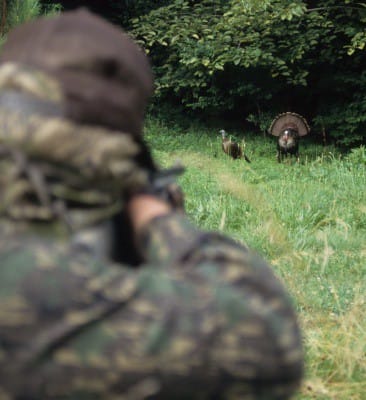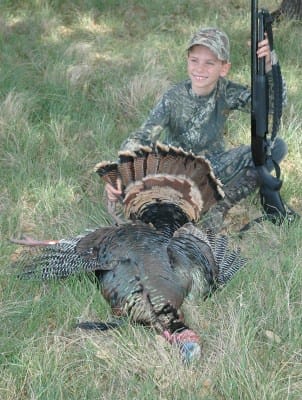J. Wayne Fears as seen on the Outdoor Wire

When you mention hunting spring gobblers with a 20-gauge shotgun, many hunters are quick to voice an opinion that the 20-gauge doesn’t have the energy to kill gobblers at any distance. While it is not a good choice for gobblers that hang up at 60 yards, neither is the 12- or 10-gauge as far as I am concerned. But when using the right load, the 20-gauge can cleanly kill a gobbler out to 40 yards, equal to the two larger gauges.
Several years ago, the Winchester Ammunition Company, using lead shot, conducted research that showed that it took 2.6 foot-pounds of energy per lead pellet to penetrate a gobbler’s skull and spinal column for an instant kill. Knowing this, if you will study some of the 20-gauge shot shell loads made today, you will see that they will carry the 2.6 foot-pounds of energy out to 40 yards and beyond.
A good example of this is the Winchester Supreme 3-inch STH2035 load, which features No. 5 lead shot. With a muzzle velocity of 1,200 feet-per-second it has a per-pellet energy level of 3.5 foot-pounds at 30 yards and at 40 yards it is 2.7 foot-pounds, energy to spare for killing a gobbler. The Winchester Supreme 3-inch X203XCT4, which is loaded with No. 4 lead shot, has a muzzle velocity of 1,185 feet-per second. It has a per-pellet energy level of 4.6 at 30 yards and 3.6 at 40 yards. The 3-inch Federal MagShok High Velocity lead load and the Remington Nitro Turkey have equal downrange energy levels for equal shot sizes and muzzle velocities. Loads such as these, when fired from shotguns that are equipped with turkey chokes that can produce tight patterns at 40 yards, make ideal turkey guns.

The main difference between the 12 or 10-gauge turkey loads and the little 20 is not so much in killing power, it is in having a pattern tight enough to consistently put pellets into the gobbler’s skull and spinal column. This is especially true at 40 yards. The edge the 12 or 10-gauge has is in the number of pellets thrown. Most 20-gauge turkey loads are in 1 ¼ ounce or 1 5/16 ounce loads containing fewer pellets than say a 1 7/8- or 2-ounce load available in the larger gauges. However, it only takes one pellet smashing the skull or spinal column to put a gobbler down; hence the 20-gauge turkey guns and loads I have been using will put several pellets in the vital area consistently at 40 yards and are devastating at 35 yards.
As more ammo companies, such as Environ-Metal with their Hevi-13 loads, Winchester with it’s Xtended Range Hi-Density loads, Federal with its Heavyweight Turkey Load and Remington with it’s Wingmaster HD loads, offer turkey loads with denser-than-lead pellets; you are going to see 20-gauges with tighter patterns and more powerful energy levels to 40 yards and beyond. The future of 20-guage loads looks bright.
The Recoil Factor
Due to an ATV accident that shattered my shoulder, it was the fact that the 20-gauge firing turkey loads has lighter felt recoil than the larger gauges firing turkey loads that first attracted me to the smaller gauge. Shooting slightly lighter loads, at a slightly lower muzzle velocity, results in less felt recoil. Combine this with a ported choke tube, one of the latest generation “reduced-recoil” recoil pads, or a recoil absorption stock, and you have a turkey gun that is fun to shoot on the pattern board range and on hunts.

The Guns
Carrying a 20-gauge turkey gun all day during the spring gobbler season can be a pleasure compared to the heavier larger gauges. The TriStar TSA I used last season weighed only 5 ½ pounds, the T/C Encore weighed in at about 6 pounds, the Benelli M2 Field 5.7 pounds. Most 20-gauge guns are lighter than the same guns in larger gauges. It hasn’t been to many years ago that the turkey hunter didn’t have a very good selection of turkey guns in 20 gauge, but those days are over. Today there are specialized shotguns in 20-gauge offered by most of the shotgun manufacturers. Besides those that are already mentioned, there are great choices in the Remington 870 and 11-87, Browning BPS, Mossberg 500, Franchi 720, and others.
Putting it All Together
Having the latest 20-gauge turkey gun and powerful turkey loads doesn’t guarantee you shooting success in the turkey woods. You must spend time on the range to find the right choke tube for the load you are shooting and then, once that is found, put in time shooting at turkey head/neck targets making sure the load-gun-choke tube combination will consistently put several pellets into the gobbler’s vitals at the range you plan on shooting. Know the downrange energy limit of the load and do not try to stretch it. If a gobbler hangs up out of range, use your other hunting skills to get him into range or try him another day. There is a place in the turkey woods for the 20-gauge and if you give it a fair try, you will find it will add something to the thrill of the sport, while giving you less recoil and a lighter gun to carry.



